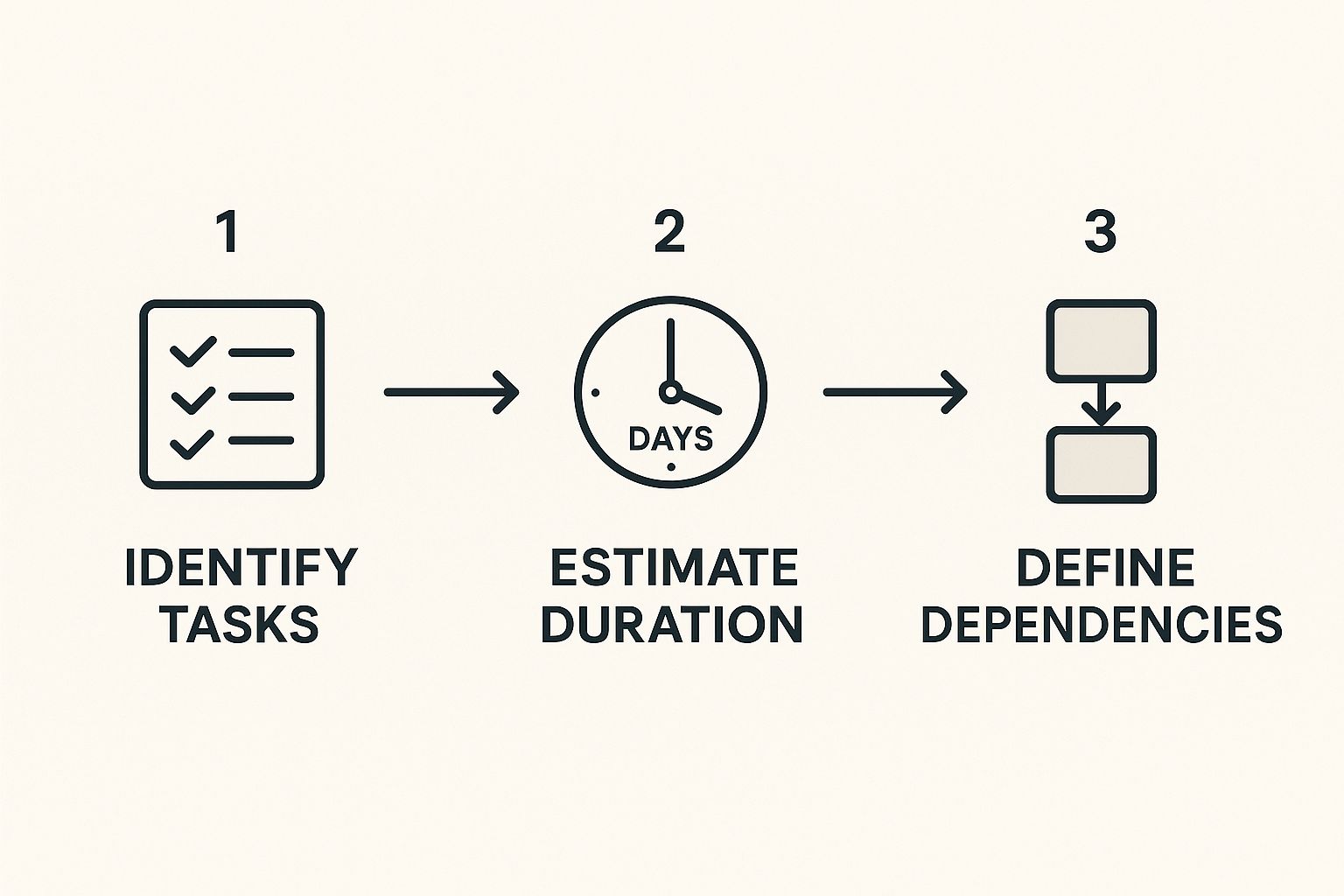Think of a project management work plan as the official playbook for your project. It's the one formal document that lays out everything—the goals, the scope, all the individual tasks, the timelines, and the resources you'll need. This plan is designed to get everyone, from your core team to the key stakeholders, on the same page from day one. It becomes the single source of truth that keeps the project moving forward and helps you measure what success actually looks like.
Your Project's Strategic Blueprint
Don't mistake a work plan for a simple to-do list. It’s much more than that; it's the project's central nervous system. It’s what connects the high-level vision with the day-to-day grind needed to make it happen. Without a solid plan, teams tend to drift into their own silos, which almost always leads to confusion, blown deadlines, and the dreaded scope creep.
Let's say you're launching a new piece of software. The development team could be heads-down coding new features, completely out of sync with a marketing team that's running a campaign on a totally different timeline. A good project work plan stops that kind of chaos before it starts by synchronizing every moving part into one unified strategy.
More Than Just a Schedule
While timelines and deadlines are a huge part of it, a truly effective work plan digs much deeper. It's the foundational document that brings clarity and control to what can otherwise feel like a messy, disorganized process.
Its real purpose is to provide structure. It does this by:
- Defining Clear Objectives: The plan forces you to answer the "why" behind the project, ensuring every task actually contributes to a meaningful business goal.
- Aligning Stakeholders: It acts as a sort of contract, setting crystal-clear expectations around deliverables, timing, and budget. No more "I thought we were…" conversations.
- Optimizing Resources: It clearly maps out who is doing what and with what tools, which helps prevent team burnout and wasteful spending.
- Mitigating Risks: By forcing you to think through potential roadblocks from the start, the plan helps you solve problems proactively instead of constantly fighting fires.
A well-structured plan is what separates project leaders who proactively guide their teams to success from those who are just reactively trying to keep a project from falling apart. It turns ambiguity into a clear, actionable strategy.
The financial stakes are surprisingly high. Poor project performance is a huge source of waste—some studies show that around 10% of every dollar invested is lost. A rock-solid work plan is your best defense against becoming another one of those statistics.
To make sure your project gets off to a strong start, it helps to build your plan around proven project management best practices. Of course, a plan is only as good as your ability to track progress against it, which is why integrating time tracking is so critical. You can learn more about how to do that in our ultimate guide to project management with time tracking. This combined approach ensures your project not only launches smoothly but stays on course until the very end.
Defining Your Project Scope and Deliverables
Before you even think about assigning the first task, you need to nail down exactly what you’re trying to build. This is, without a doubt, the most critical part of your project management work plan.
Vague goals are project killers. Something like "improve the website" sounds productive, but it’s a recipe for disaster. It leads to endless revisions, frustrated stakeholders, and a finished product that pleases no one. What you need is a rock-solid foundation of clarity from day one.
That foundation begins by turning those fuzzy aspirations into something concrete. We do this by setting SMART goals—objectives that are Specific, Measurable, Achievable, Relevant, and Time-bound.
So, "improve the website" becomes: "Increase qualified lead form submissions on the website by 15% within the next quarter." See the difference? That simple shift gives your team a clear target and a definitive way to measure success.
Uncovering the Real Requirements
With a clear objective in hand, it’s time to dig into the specifics with the people who matter most: your stakeholders. A good stakeholder interview isn't about asking what they want; it's about understanding what they truly need to solve a business problem.
You have to go in prepared. Arm yourself with open-ended questions that get to the heart of their motivations and pain points. Try asking things like:
- What does a successful outcome look like for your department in six months?
- What's the biggest operational hurdle this project needs to clear for you?
- Let's talk about what's "out of scope." What should we explicitly agree not to do right now?
Listen more than you talk in these meetings. You'll often uncover hidden requirements or potential conflicts that weren’t obvious on the surface, saving you from costly headaches down the road.
A well-defined scope statement is your project's constitution. It's the document you and your stakeholders sign off on, clearly stating what's included and—just as importantly—what's not.
Deconstructing the Project with a WBS
Okay, you've got your objectives and a pile of requirements. Now, how do you break that huge goal into manageable chunks? This is where a Work Breakdown Structure (WBS) is your best friend. A WBS is a simple, hierarchical way to break down the total scope of work.
Think of your project as a house. The WBS isn't a list of every single brick and nail. Instead, it breaks the house down into major systems: foundation, framing, plumbing, electrical. Each of those systems can then be broken down into smaller, more manageable packages of work.
For our website redesign example, the top-level deliverables might look like this:
- Phase 1: UX/UI Design
- Phase 2: Front-End Development
- Phase 3: Back-End & CMS Integration
- Phase 4: Content Migration & SEO
Each phase is then broken down further into specific deliverables, like "Wireframe Creation" or "API Integration." This approach ensures no major component gets missed and gives you a clear framework for estimating timelines and assigning resources as you continue building out your project management work plan.
Building Your Project Timeline and Dependencies
Okay, you've got a clear scope and a detailed task list. Now it's time to give your project a heartbeat—the timeline. This isn't about just randomly plugging dates into a calendar. We're talking about really digging into the flow of work, figuring out how long each piece will take, and understanding how every task connects.
A huge mistake I see all the time is project managers pulling estimates out of thin air. Your estimates have to be grounded in reality. If it's a project you've handled before, like a standard website build, use your historical data. But for something brand new? Try a three-point estimation. That's where you map out the best-case (optimistic), worst-case (pessimistic), and most likely scenarios to land on a solid, weighted average.
This is the process that turns a simple checklist into a dynamic, living schedule.
Sequencing and Mapping Dependencies
With some rough time estimates in hand, you need to figure out the right order of operations. This is where you map out task dependencies—the relationships that dictate what has to happen before something else can begin.
Think about it: you can't start coding the user interface until the wireframes are approved, right? That's a classic finish-to-start dependency, and mapping these out is absolutely critical. It reveals the project's natural workflow. Forgetting even one key dependency is a surefire way to cause delays.
Imagine the content team needs the final design assets before they can write the copy. If you don't map that dependency, you’ve just created a bottleneck that was completely avoidable.
This infographic breaks down the basic flow for building a realistic schedule.
As you can see, scheduling is a logical sequence: identify the work, estimate the effort, and then link it all together.
The best way to see this all come together is with a Gantt chart. This tool gives you a crystal-clear bar chart view of your project timeline, showing the start and end dates for every task and how they all overlap. Honestly, it’s the single best way to see the entire project flow at a glance.
The real power of a Gantt chart is its ability to expose the critical path—the longest sequence of dependent tasks that determines the shortest possible duration for the entire project. Any delay on this path directly delays the project's completion date.
Identifying the Critical Path and Slack
Finding the critical path is a total game-changer. It tells you exactly which tasks have zero wiggle room. These are the ones you need to watch like a hawk because they have no slack (also known as float).
Any task not on the critical path has some slack, meaning it can be delayed a bit without pushing back the final project deadline. Knowing the difference helps you focus your attention and manage your resources way more effectively.
If a non-critical task is running a bit behind, you might have some breathing room. But if a critical path task slips? It’s an all-hands-on-deck situation. To really get a handle on this, check out this guide on how to calculate slack time.
Let's say you're working on a software development project. The critical path might look something like this:
- Finalizing the database schema
- Developing the core API endpoints
- Integrating the front-end with the API
- Conducting user acceptance testing
Meanwhile, a task like designing the marketing materials might have a week of slack, giving that team a lot more flexibility. By focusing your energy on the critical path, you start managing your project proactively instead of just reacting to problems. This is how your timeline becomes a powerful, strategic tool for managing risk.
Assembling Your Team and Allocating Resources
Once your project's timeline and dependencies are mapped out, it’s time to shift focus to the most critical part of any project: your people. A work plan is nothing without the right team to bring it to life, equipped with the tools they need to succeed.
This is where the plan moves from the abstract "what" and "when" to the very real "who" and "how." It starts with an honest look at the skills needed for every phase. You’re not just looking for technical chops; you need the right mix of soft skills to keep collaboration humming and solve problems on the fly.
Defining Roles With a RACI Chart
Nothing stalls a project faster than confusion over who’s supposed to do what. To cut through that ambiguity right from the start, a RACI chart is your best friend. RACI stands for Responsible, Accountable, Consulted, and Informed, and it’s a simple way to clarify roles for every single task.
- Responsible: This is the person (or people) actually doing the hands-on work.
- Accountable: The one person who ultimately owns the task and has the final say. Think of them as the buck-stops-here person.
- Consulted: These are your subject matter experts. They provide input and feedback, but they aren't doing the work.
- Informed: People who need to be kept in the loop on progress, like stakeholders or department heads, but aren't directly involved.
By setting up a simple matrix with tasks on one side and team members on the other, you kill confusion before it starts. This isn't just a chart; it's an exercise that builds a culture of ownership from day one.
A well-constructed RACI chart acts as a social contract for the project team. It transforms vague assumptions about who's doing what into a clear, agreed-upon framework for execution and communication.
To make this more concrete, let's look at a quick example. Imagine you're tackling a website redesign. A RACI chart helps ensure everyone knows their part, preventing tasks from slipping through the cracks.
RACI Chart Example for a Website Redesign Project
| Task/Deliverable | Project Manager | Lead Developer | Content Strategist | Marketing Lead |
|---|---|---|---|---|
| Finalize Design Mockups | A | R | C | I |
| Develop Homepage | A | R | I | I |
| Write All Website Copy | A | I | R | C |
| Set Up SEO Strategy | A | C | R | R |
| Launch Marketing Campaign | A | I | C | R |
This simple grid makes it instantly clear that while the Marketing Lead is Responsible for the launch campaign, the Project Manager is ultimately Accountable for it happening on time. It’s a powerful tool for aligning your team.
Budgeting for More Than Just People
Your team is your most valuable asset, no question. But a realistic budget has to account for everything else needed to get the job done—software, equipment, ad spend, you name it. A huge piece of this puzzle involves mastering project management resource allocation to make sure every dollar and tool is used effectively.
The right tech is non-negotiable these days. In fact, the global project management software market is on track to hit $12.02 billion by 2030. That number tells a story: budgeting for tools that make collaboration and tracking easier isn't a luxury, it's a necessity. For more stats like this, the team at Monday.com often shares some great insights.
The Art of Resource Leveling
So, you've assigned tasks and allocated your budget. The last check is to make sure you haven't accidentally burned out your team before you've even started. This is where resource leveling comes in. It’s the process of adjusting your schedule to prevent over-allocating any single person. Think of it as proactive burnout prevention.
For instance, if you look at the plan and see your lead developer is slated for 60 hours of work in one week, that's a red flag. Something’s got to give. Resource leveling means you either push back a few non-critical deadlines for that developer or reassign some of their tasks to another team member who has the bandwidth. It's all about maintaining a sustainable pace to keep the project—and your team—running smoothly. If you want to dig deeper into this, we’ve got some helpful advice on effective resource planning.
Monitoring Progress and Managing Change
Here’s a hard truth: your project management work plan is not a "set it and forget it" document. Think of it more like a GPS. Once the work starts, your job isn't just about having the map; it's about actively steering the car, navigating the detours, and making sure you're still heading toward the destination.
This means you’re constantly checking your progress against the baseline you worked so hard to establish. And, just as importantly, you're managing the inevitable changes that will pop up along the way.
Effective monitoring isn't about breathing down your team's neck. It's about setting up a solid rhythm of communication and using the right data to get a clear, honest picture of where things really stand. Regular check-ins, whether they're quick daily stand-ups or more detailed weekly status meetings, are your best friend here.
Keep these meetings sharp and to the point. The goal is to spot roadblocks before they become disasters and to celebrate small wins to keep morale high—not to get bogged down in circular discussions. This is your time to review the key performance indicators (KPIs) that tell you if you're truly on track.
Tracking the Right Metrics
Vague updates like "we're making good progress" are the enemy of a well-run project. You need cold, hard data to actually understand the health of your project. Don't overwhelm yourself; just focus on a few core metrics that give you real insight.
- Schedule Variance (SV): This is a simple but powerful one. It compares where you actually are in the schedule versus where you planned to be. If your SV is negative, you're behind schedule. It’s an early warning sign that lets you take corrective action before things get worse.
- Cost Variance (CV): Just like SV, but for your budget. It tracks your actual spending against what you budgeted. This is how you catch budget overruns before they completely spiral out of control.
- Task Completion Rate: This is a direct look at your team's productivity and the accuracy of your original estimates. Simply track the percentage of tasks being completed within their estimated timeframes.
These KPIs turn your work plan from a static piece of paper into a dynamic dashboard for controlling your project's destiny.
Change is the only constant in project management. Resisting it is futile; the key is to manage it with a structured, predictable process. An uncontrolled change is how 'scope creep' slowly but surely destroys your timeline and budget.
Implementing a Change Control Process
Let's be realistic: no project goes exactly according to plan. A client will suddenly ask for a new feature. A technical issue will force you to change direction. Without a formal process for handling these curveballs, you're inviting chaos. A change control process is your safeguard against this.
This process ensures that every single proposed change gets properly reviewed, evaluated, and approved before anyone starts working on it. It’s a simple, but incredibly powerful, workflow.
- Submit a Change Request: First, anyone proposing a change has to document it. What is the change? Why is it needed? What’s the potential impact? Get it all down in writing.
- Evaluate the Impact: Next, the project manager (that’s you!) assesses how the request will affect the project's scope, timeline, budget, and resources.
- Approve or Reject: Key stakeholders then review that assessment and make a formal decision. It's a clear yes or no.
- Update the Plan: If it gets the green light, the change is officially integrated into the project management work plan. All related documents are updated to reflect the new reality.
This structured approach stops random, undocumented changes from derailing your project. It keeps everyone on the same page and makes sure every adjustment is a deliberate, strategic decision—not just a knee-jerk reaction.
Common Questions About Project Work Plans
Even with the best guide in hand, you’re bound to hit a few snags when you're deep in the trenches of building a project work plan. Let’s tackle some of the most common questions that pop up, with clear answers to get you unstuck and moving forward.
How Detailed Should My Work Plan Be?
This is the classic "how long is a piece of string?" question. The truth is, it completely depends on your project’s complexity and who's on your team.
If you're running a small, straightforward project with a crew of seasoned pros, a high-level plan mapping out the major milestones might be all you need. They know what to do without you spelling out every single step.
But for a sprawling, multi-department project tangled up with dependencies? You’ll need to get way more granular. A good rule of thumb is to break down the work until each task is a clear, manageable chunk. Can one person or a small team knock it out in a few days or a week? If so, you’re probably at the right level of detail.
Your project plan needs to be detailed enough to kill ambiguity, but flexible enough to roll with the punches. If your team is constantly asking, "What's next?" you haven't gone deep enough. If you spend more time updating the plan than doing the work, you've gone way too far.
What’s the Difference Between a Project Plan and a Project Charter?
It's easy to get these two mixed up, but they play very different roles.
Think of it like this:
- The Project Charter is the project's official "birth certificate." It's a short, formal document that gives the project the green light. It names the project manager, outlines the big-picture objectives, and identifies key stakeholders. It’s all about the why and the who.
- The Project Work Plan is the detailed operational roadmap. This is where you break down those big objectives from the charter into actual tasks, timelines, and resource assignments. It gets into the nitty-gritty of the what, how, and when.
Basically, the charter gives you the authority to start the journey, and the work plan is the map that shows you how to get to the destination.
How Often Should I Update the Plan?
Your work plan is a living document, not something you carve in stone and hang on the wall. It needs to evolve as the project does.
You should update it anytime new information throws a wrench in your scope, schedule, or budget.
For most projects, a weekly review and update is a solid rhythm. It gives you a chance to look back at what got done, tackle any roadblocks that came up, and adjust the forecast for the weeks ahead. If you’re on a fast-moving agile project, you might even need quick daily check-ins to keep the plan tethered to reality.
At TimeTackle, we know a plan is only useful if you can see how you're tracking against it. Our platform connects to your calendar to give you a real-time view of where your team’s effort is actually going. This helps you keep your project work plan accurate and on track, without the guesswork. See how it works at https://www.timetackle.com.







